ROLE: product designer
Project Brief:
Currently, when an existing Investor purchases new homes and wants to add them to Origin platform (the company software) , they are sending data/info to a Darwin team member, who then notifies Engineering to upload properties into Origin. This not only creates huge inefficiencies but also increases room for error with multiple handoffs.
Currently, there isn’t a place in Origin (the company software) to review what has been added/uploaded before it goes live. Without the proper sign-offs in the beginning of this process, both internally and externally, this leads to downstream inefficiencies across teams.
Currently, when an existing Investor purchases new homes and wants to add them to Origin platform (the company software) , they are sending data/info to a Darwin team member, who then notifies Engineering to upload properties into Origin. This not only creates huge inefficiencies but also increases room for error with multiple handoffs.
When factoring in the expected scale of homes and the amount of time required to onboard a new home (~10-15 mins per new home onboard) for an Ops team member, the annual cost (and potential impact to this design change) was estimated to be $80k in labor. Investors should not have to rely on a Team Member to add a new home onto Darwin’s platform, therefore, when I was assigned to this project, I set out change this experience into a self-import automated import tool.
Notes: SOFTWARE DESKTOP ONLY EXPERIENCE
Impact:
"The annual labor cost (and potential impact to this design change) was estimated to be $80k"
Credit - Made by me: Ana Peralta
Design Discovery
Documenting current experience to scope out friction points
The below chart documents where the experience stood at the start of my audit and research prior to making proposed design changes. This diagram helps visualize how multiple teams and rounds of checks and balances were involved and lead to constant re-edits and re-visitations to review the data. It was clear here that by getting it right the first time, the whole experience could be streamline and reduced.

Credit - Made by the previously assigned designer (who did Onboarding 1.0)
The most valuable thing I learned were that the most valuable artifact to the data ingestion experience was the quality of an asset called a "data tape". It was what harbored all the information in certain place, in a certain order with the proper formatting and it would determine how seamless or complicated an import would be. It served as a template in which client software and our software would "read" and attempt to "match each other". The better the "matching" to the same data variable naming convention and formatting, the smoother the automated intake, otherwise, this was a friction point for Ops to dedicate time to "clean up" the sheet to match formats to better hand-off. This was in NO WAY easier than manually entering the data into the software and wasn't a scalable solution.
I summarized the value of it below:
ABOVE: Screenshot example of a date tape
usability testing: Client interview
In preparation of the client interview, my Product Manager and I congregated to align on a game plan for the goals of the Research conducted. I was in charge of leading and conducting a 30-45 minute 1:1 interview with an existing Investor client (BLVD a professional property management group - a client that has their own property database properly streamlined and automated) as a model example to understand their needs, preferences, behavior, best practices etc as a way to model the ideal company-client hand off method and set the design standard around this. to ensure the feedback and insights received in the sessions will help answer the research objectives and goals.
The Research goals and objectives that were agreed upon are as follows:
Objective 1: Streamlining New Client Onboard
Objective 2: Allowing existing client onboarding to be self-initiated by our clients and kicking off all necessary internal workflows
User collected Feedback and Pain points
Below, I have illustrated the questions (yellow) and the answers (green) from that session to ensure the feedback and insights received in the sessions will help answer the research objectives and goals.
Questions in yellow and the answers in green
Credit - Made by me: Ana Peralta
Credit - Made by me: Ana Peralta
Research Learnings and Insights
1. Investors rather fix edits in their source data than inline editing so that their data source (original data sheet) and books are reflective of this too. Creates duplicate work and how will they know what they have or haven’t done. So table and inline edits don’t provide ADDED efficiency just creates double data source
2. They like how the table calls out validations and errors
3. Their software mainly only flags MISSING FIELDS
4. Urgent says where manual uploading may come in handy when automation won't arrive in time - END OF MONTH time frame to close accounting books
5. Wants all property info reflected in Origin to be achievable
6. If template changes, it's minor effort to rearrange or rename or add new data points
7. If data tape adjustments are made, it takes minor effort to adjust. Just required some communication from both ends on the specifics
8. Out of cycle opportunity = end of month accounting close time may be a time where automation timing won’t reach deadline therefore that would be an opportunity where the time crunch would benefit from manual entry
9. Set the toggle to default so that focus is set on the errors and reduce the steps to finding errors
Targeted Personas
Although there is no official Persona documentation at my employers', below, is a quick draft of what I learned about software's users base and end user base. The ones we focused on were the Ops (blue) and the Investor (green).

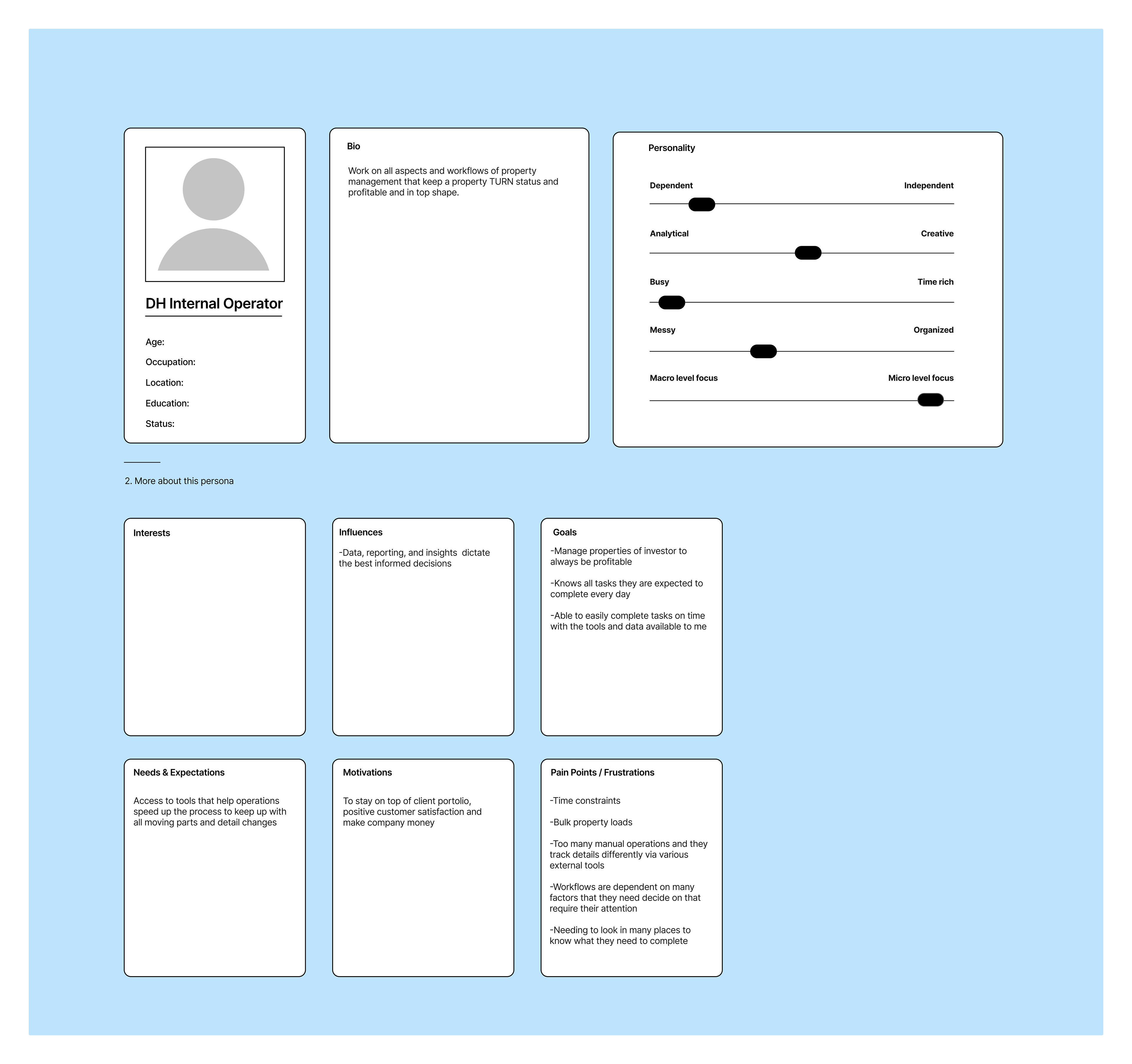
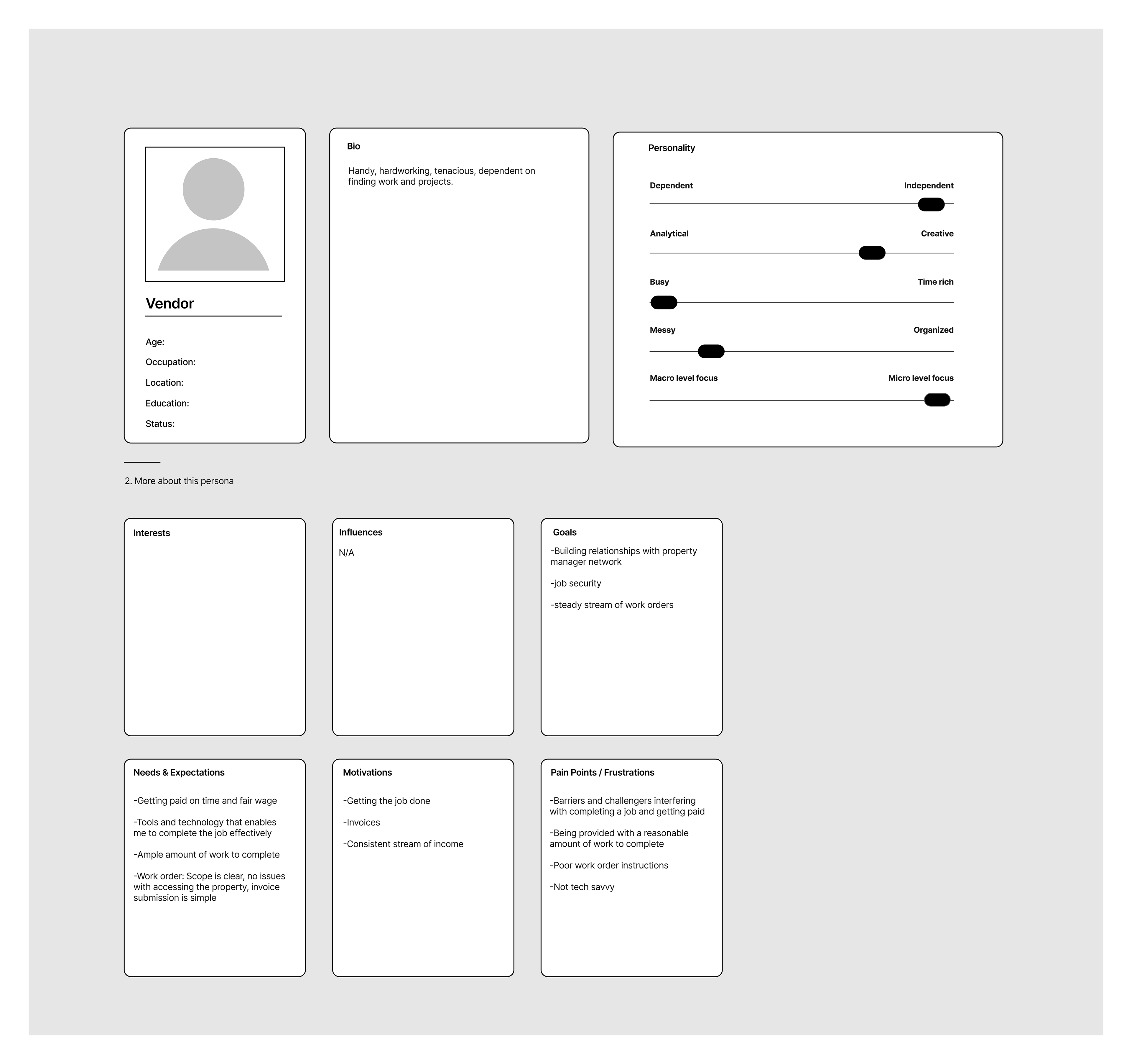
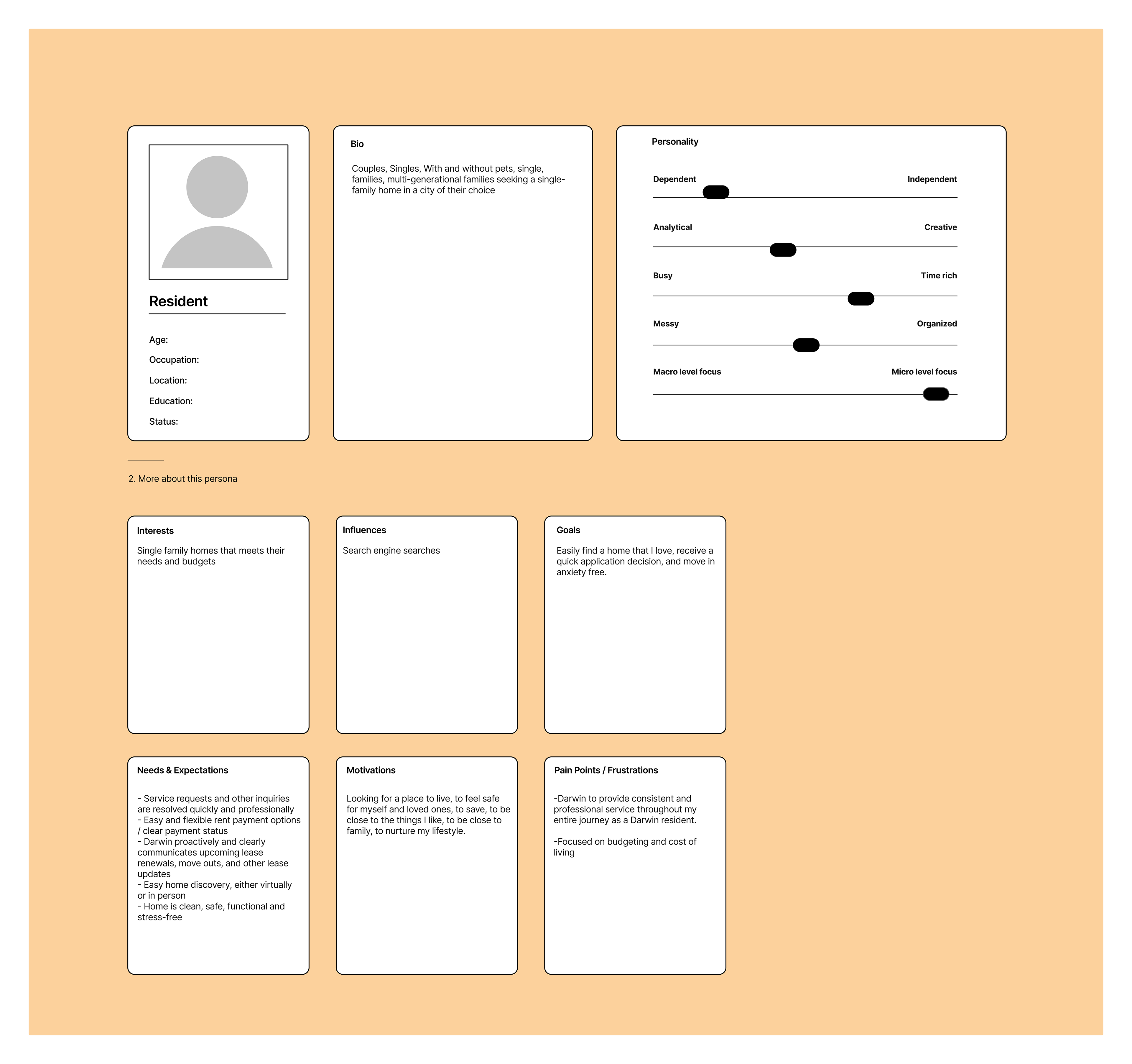

Credit - Made by me: Ana Peralta
Metal Model:
Questions target users were most likely to ask during an import:
Questions target users were most likely to ask during an import:
Can I upload XLS, XLSX, CSV, or XML files?
What if my file size is ## MB?
Is it a problem if my file has special characters in column headers?
What happens if my spreadsheet columns do not match the required fields?
How do I fix my data? Do I need to save a duplicate CSV and upload that file instead?
competitive analysis
Design Inspo sources: Front.com, Thoughtspot.com, Dribbble, Smashing Magazine
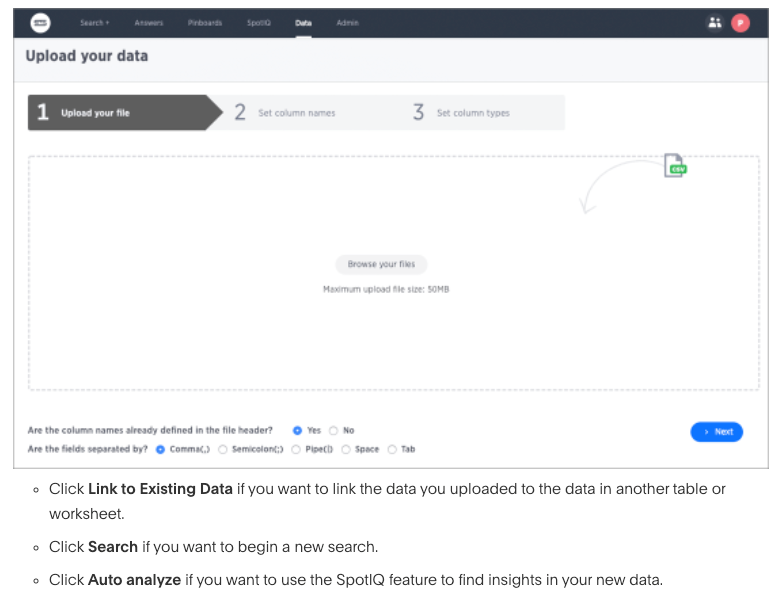

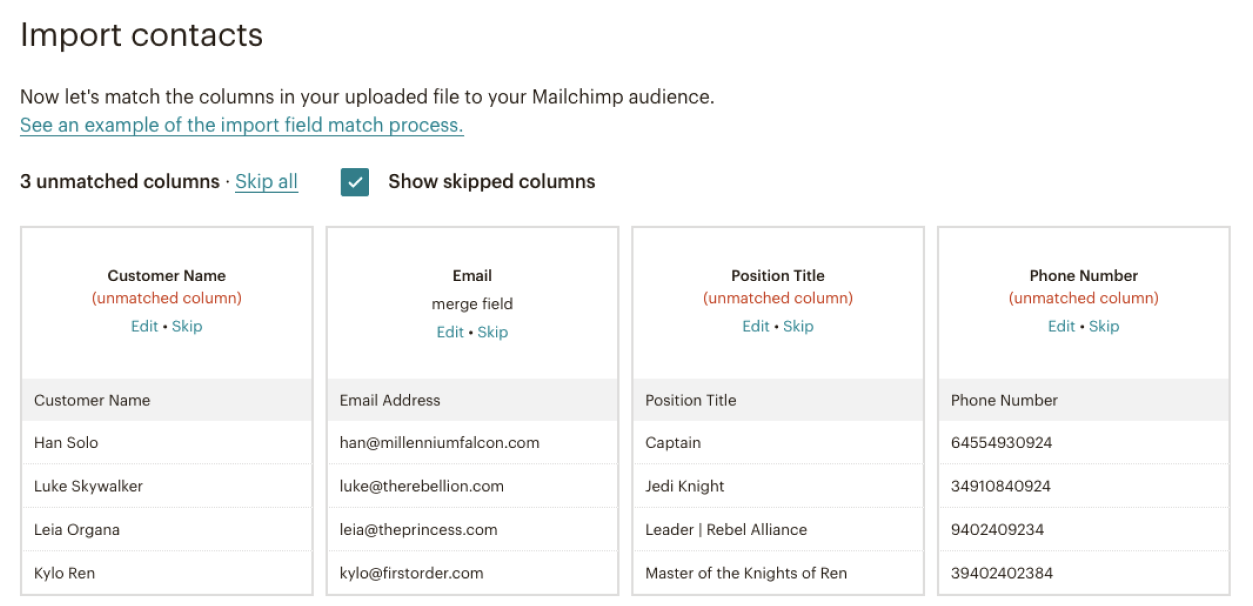

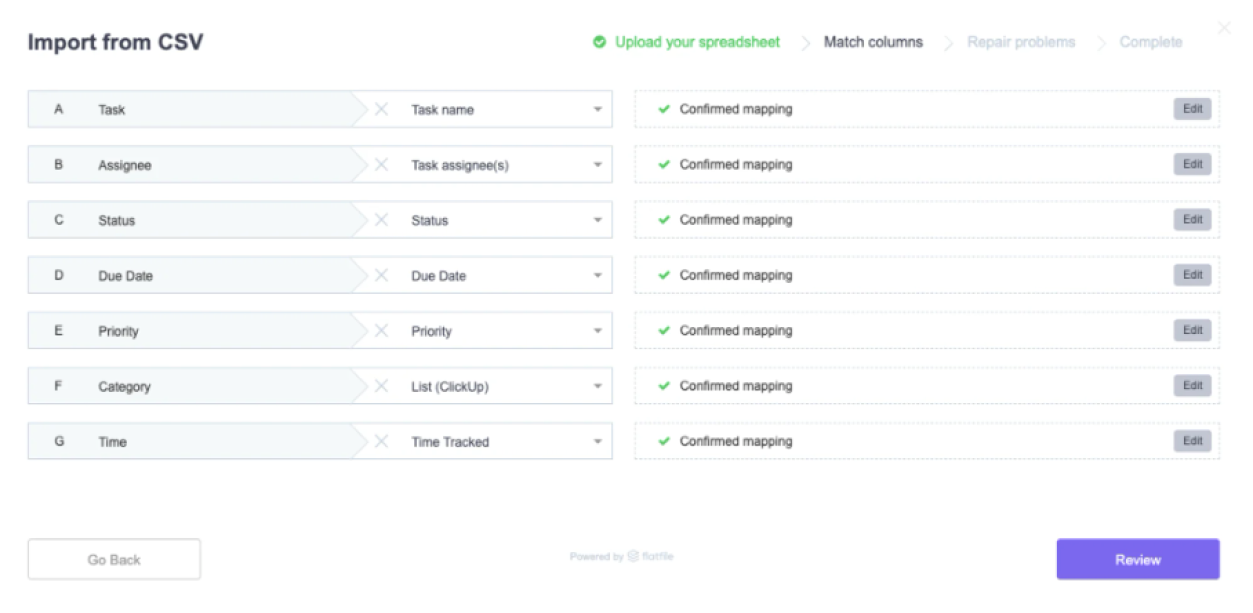
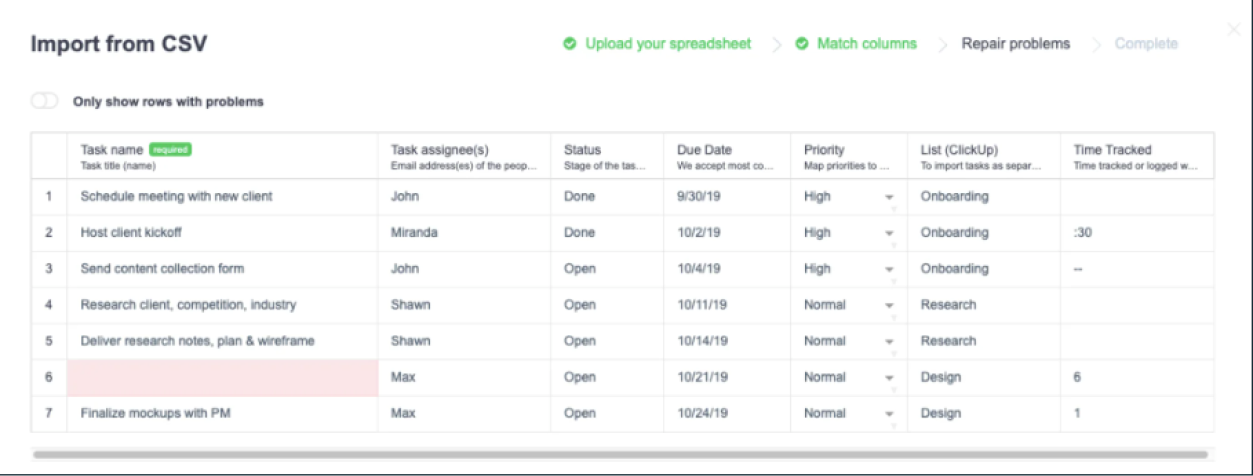

Design and ideation
Design solution North Star: (Ux-LEd)
I drafted goals presented at design sprint kickoff for alignment:
1. 100 % Ongoing Onboards initiated and triggered by Clients directly to kick off property onboarding process
2. Collecting sufficient info/data in order to begin management
3. Launch Ops team is able to review and validate info provided by Clients before marking it as Active Management
4. Kicking off the correct internal workflows when a new property is onboarded
5. Elimination of manual handoffs between Ops team and Engineering
Short term
• Ability to add new homes directly from Investor Portal
• 100% ongoing onboards triggered and initiated directly by Clients to kick off proper onboarding process
• Proper T&Ws kick off at the defined time frame
Long Term
• Ability for Clients to add documents directly via Investor Portal (to reduce manual work on our teams)
• Ability to purchase and add more new homes directly via Investor Portal
Reshaping the experience
Changes to the NEW flow: (Updated journey map below)
1. When user uploads file, show them a preview of what has been uploaded
2. Show an awaiting indicator at the right side of a row and while that indicator is revolving do a validation of the row
3. If the row is valid, then show a selected checkbox in the place of that wait-indicator to tell that the user that this row is good to the uploaded.
4. If the row is invalid, then show a red cross mark in place of that wait indicator while clearly highlighting the column that is not a a valid input
5. Finally, placed a button at the bottom of that preview page (preferably a sticky footer) that will finally submit those valid rows after which checkboxes are selected.
6. Provide specific invalid formatting links at the row level by means of tooltip or icon or helper text, perhaps a pseudo row underneath that explains the exact error and how to recover/edit it if possible.
Design Objectives
1. Provide clear instruction or guidance for bulk upload feature regarding the acceptable format file and file size
2. Create our core bulk attributes for mapping the attributes on the user’s file
3. Provide clear error messages
4. Create knowledge base center regarding import file by using bulk upload
Design Goals
1. Improving hassle-free file import on bulk upload feature
2. Increase customer satisfaction and less frustration in uploading bulk data
3. Reduce internal churn and hand-off on customer data onboarding
Credit - Made by me: Ana Peralta
delivered design solutions - Overview

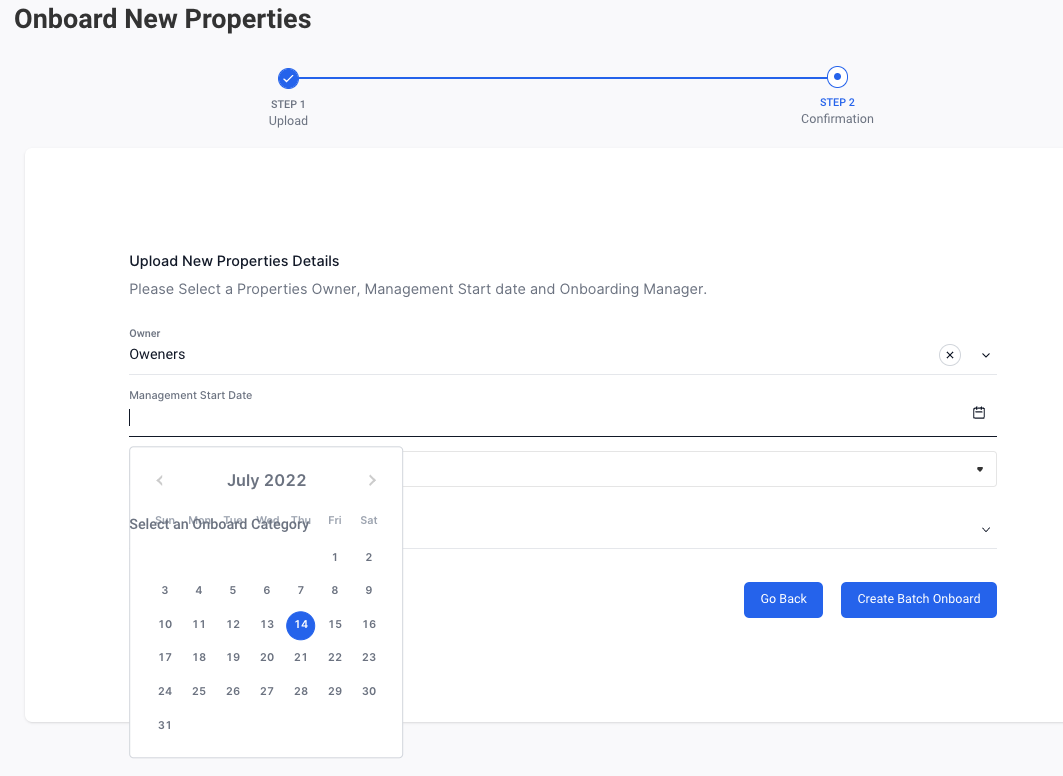
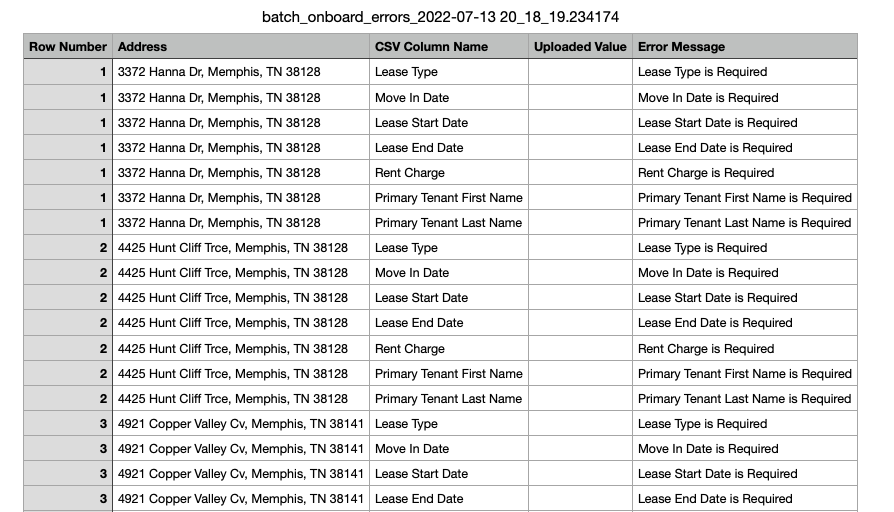

delivered design solutions - The Happy Path

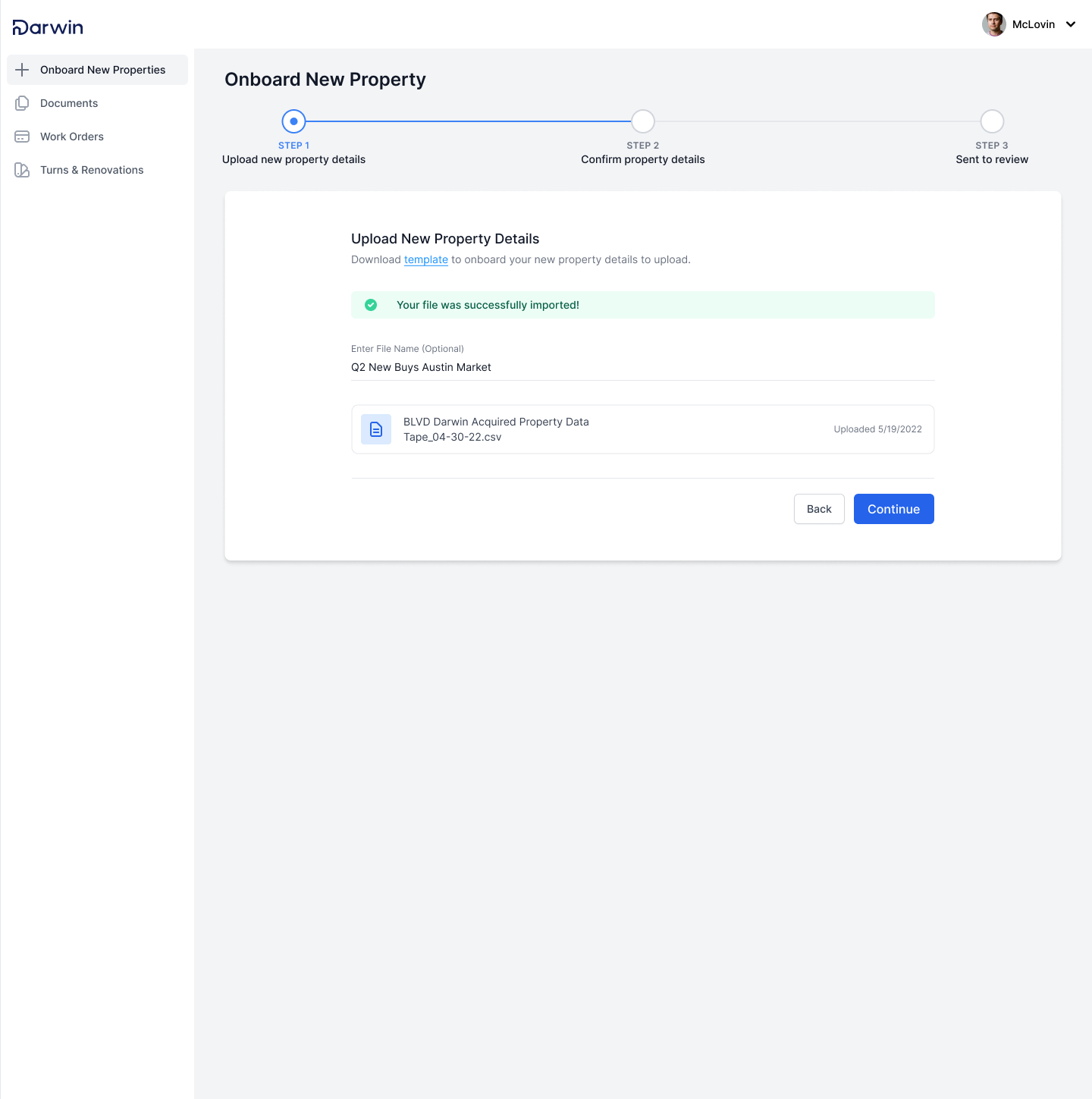
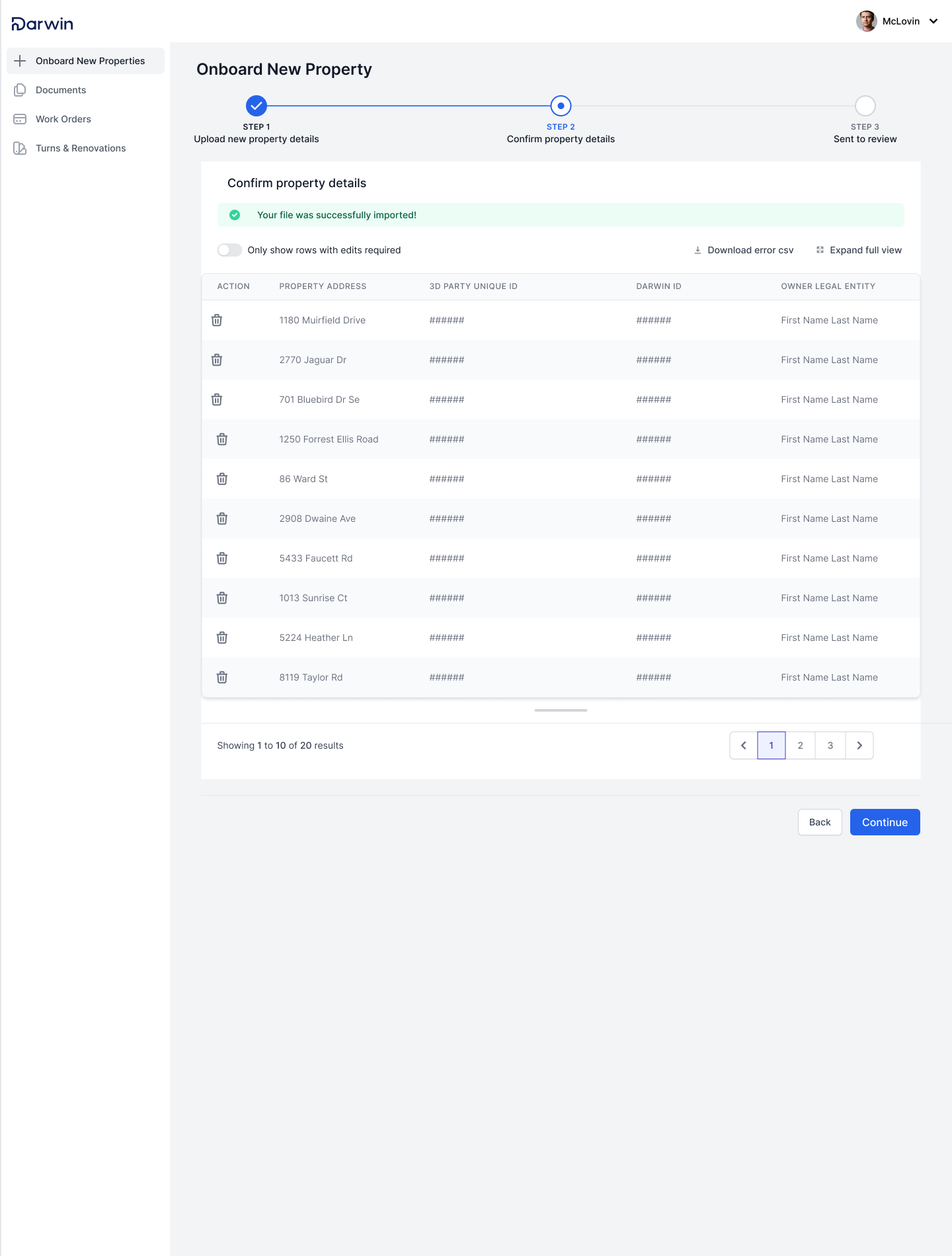
delivered design solutions - Error States
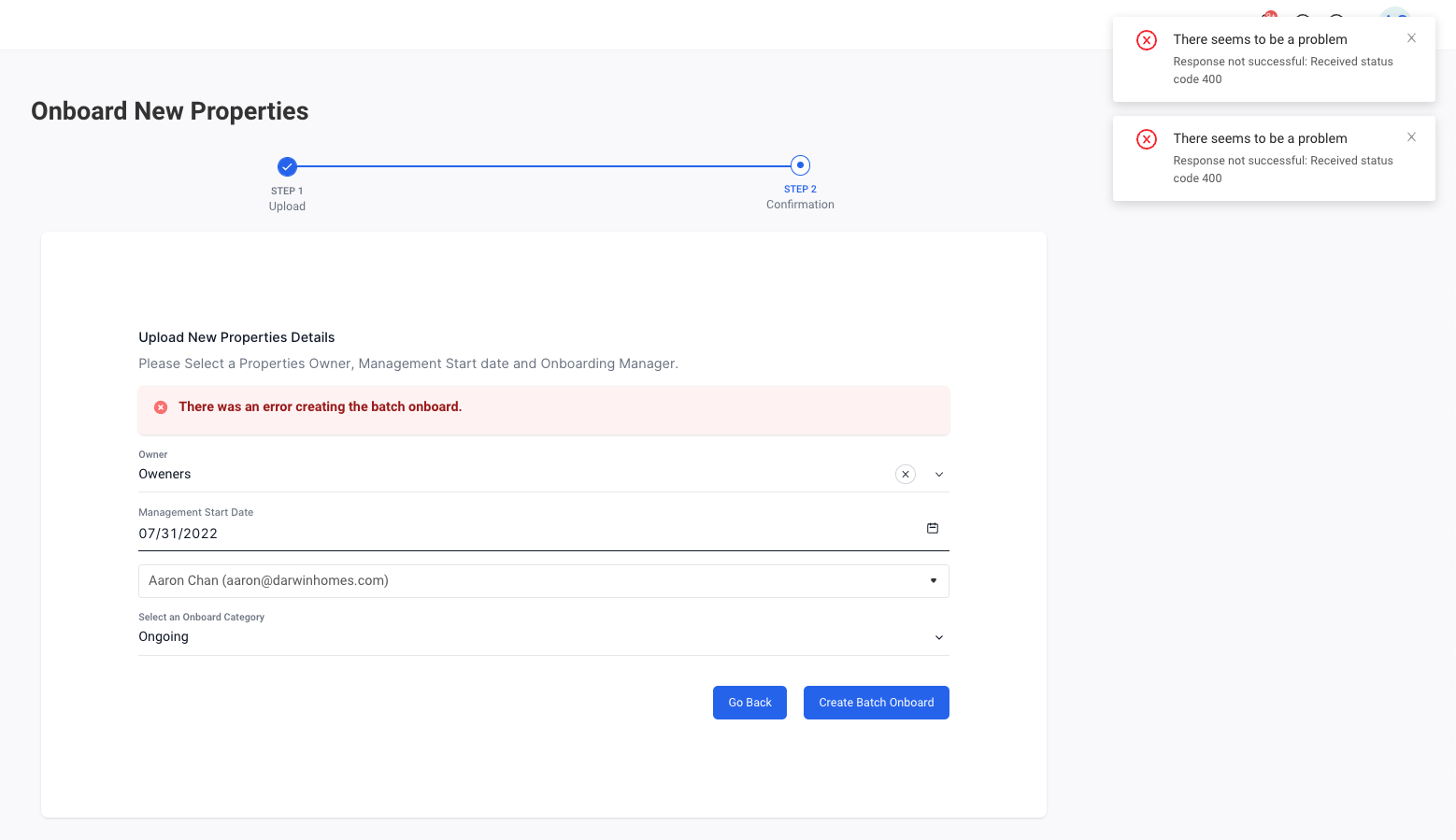

Credit - Made by me: Ana Peralta
Key features
Solution 1: CSV Upload (Client) → Data Entry (Darwin)
• Add a new Onboarding page on IP
• Ability for Client to upload CSV files with new property data
• Client confirms and submits
• Darwin team member enters data/info into Origin
• Internal review before pushing to Active Management (internal workflow status)
Solution 2: CSV Upload (Client) → Data Ingestion (System)
• Data Upload & Ingestion
• Add a new Onboarding page on IP
• Ability for Client to fill out an online form for single new home onboard
• Ability for Client to upload CSV files with new data
• Client confirms and submits
• Data feeds into new onboarding tool
Validations
• Required fields must be filled out in CSV data tapes in order to upload
• Required fields must be filled out in the correct format
• Making sure that fields that are conditional throw an error if it doesn’t make sense. Logic example: Lease info is required IF Occupancy Status is set to Yes
• Line item limit: 50
Notifications
• Successful upload (IP)
• Unsuccessful upload with specific error message (IP)
• Successful upload (Origin w/ [customer.io](http://customer.io) notifications)
• Unsuccessful upload (Origin w/ [customer.io](http://customer.io) notifications)
• Push to `Active Management` (IP and Origin)
• Unsuccessful upload with specific error message (IP)
• Successful upload (Origin w/ [customer.io](http://customer.io) notifications)
• Unsuccessful upload (Origin w/ [customer.io](http://customer.io) notifications)
• Push to `Active Management` (IP and Origin)
User Testing
Status: Passed
Status: Passed
I teamed up with Product and Engineering to define the task and scale for categorizing the responses. We asked a few select Ops member to fulfill the task of uploading a spreadsheet and attempt to onboard new properties to the Origin software in Staging environment.
The following 3 questions to assess how well the design addressed the problem statements.
1. Rate the usability of the current iteration of the product (Red/Yellow/Green). Give 1-3 summary sentences on why this rating - PASS
2. Rate the collaboration between Ops and Product (Red/Yellow/Green). Give 1-3 summary sentences on the rating (what is working well, what are some areas for potential improvement) - PASS
3. Where are opportunities where you as an Ops leader can improve to ensure a more successful launch? [training, feedback to product team, deeper reviews] - PASS


Images above document the testing scale and task focus areas assessed to measure success of Design solution.
conclusions
Benefits of New Design
• Provide clear guidance
• Set expectations on platform memory and file size limitations
• Provides clarity on WHY data import failed?
• Clarity and explicit specificity in the errors (ie no nulls)
• Recognizing “Required” fields
• Column-matching or column-mapping functionality(manual option lets users preview what sort of data can be imported into the productivity software)
• Import modal includes really well designed
• Users get a chance to confirm CSV labels and clean up the spreadsheet results before importing their data without having to leave the software. Once all spreadsheet labels have been resolved, the user can easily “Confirm Mapping” or discard the column altogether if it is proven unnecessary
• Highlights required fields that are empty, contain an obvious error or divert from the data model
• The “Only show rows with problems” toggle in the left-hand corner makes it even easier to spot.
• Complex validation for things like normalizing phone numbers or date formats
• Provides a recommended data tape template file with explicit detail and guided instructions for seamless import experience
results and achievements
• $80k of labor recuperated (annually)
• Post-launch update: No reported issues. Reportedly considered a 'flawless' design update.

